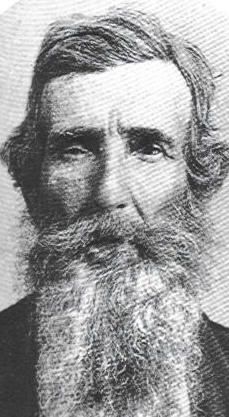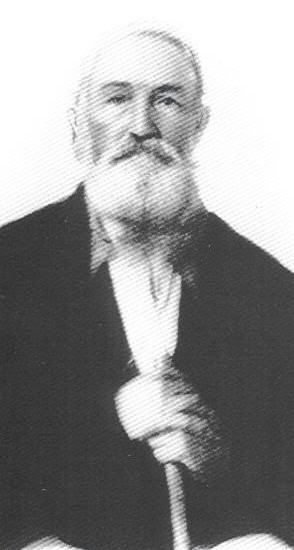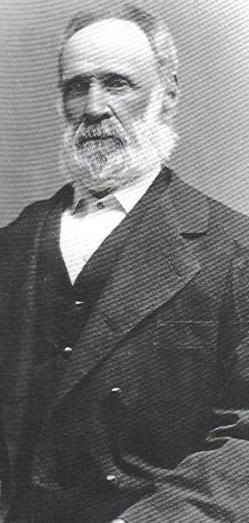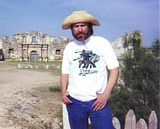|
|
Post by neferetus on Jan 20, 2006 1:05:03 GMT -5
Surviving Alamo couriers, photographed much later in life. BENJAMIN HIGHSMITH Teenage courier who was sent to Fannin just before the siege began. Returning, he was turned back and pursued by a Mexican cavalry patrol but escaped. Met James Bonham, another returning courier, and urged him to turn back, but the latter pressed on. Highsmith later took another message to Fannin for Houston, and was at San Jacinto. He was later in the Texas Rangers, and died in 1905.  DR. JOHN SUTHERLAND According to his own account, he and John W. Smith were sent out by Travis on February 23, 1836 to check out the sentry in the San Fernando Church's claim that he had seen Mexican cavalry. As the account goes, Sutherland's horse folded on him on the return to town, badly injuring his leg. He later left the Alamo with a dispatch from Travis, never to return. Of late historians have begun to doubt as to whether Sutherland was even in San Antonio on the 23rd. (Some claim that he had left Bejar a few days prior to that and so never actually saw the approach of Santa Anna's army, or any of the events of the Alamo's first day of siege, for that matter. One of the few persons who claims to have seen Sutherland in Bejar on the 23rd was merchantman Nat Lewis, who later stated that Sutherland had been in his shop helping with inventory when the sentry in the San Fernando church began ringing the signal bell. Even at that, Nat Lewis himself left San Antonio on foot, telling John W. Smith a little ways out of town, "I'm a businessman, not a fighter.")  WILLIAM S OURY Was sent out as a courier and later was at San Jacinto. Later was with the Mier Expedition, survived that disaster, only to end up in the Texas Rangers in the Mexican-American War. He joined the California gold rush, and ended up as sheriff of Tuscon, Arizona.
|
|
|
|
Post by Bromhead24 on Jan 20, 2006 10:03:32 GMT -5
I can't remember their names but there two brothers there that Travis had a hard time in making his decision as to who would be a courier should he pick the older brother or the younger one which he sent out on march 3rd or 4th. It was portrayed in POF.
|
|
|
|
Post by neferetus on Jan 26, 2006 12:56:36 GMT -5
I can't remember their names but there two brothers there that Travis had a hard time in making his decision as to who would be a courier should he pick the older brother or the younger one which he sent out on march 3rd or 4th. It was portrayed in POF. James Allen was finally chosen. However, the real James Allen was actually 21 years old when he rode out of the Alamo on the evening of March 5th. Here's Bill Groneman's bio on Allen that appears in the Handbook of Texas: ALLEN, JAMES L. (1815-1901). James L. Allen, the last messenger from the Alamo,qv son of Samuel and Mary (Lamme) Allen, was born in Kentucky on January 2, 1815, the eldest of seven children. His father, a veteran of the Indian wars, had served under Gen. William Henry Harrison. Allen was a student at Marion College, Missouri, when he joined other students to volunteer for military service in Texas. He left the Alamo on courier duty on March 5, 1836, the night before the battle of the Alamoqv took place. He served at San Jacinto as a scout under Erastus (Deaf) Smithqv and helped burn bridges behind Mexican lines to cut off their retreat. After the victory at San Jacinto, he returned to the United States, where he stayed for two years. He then settled in Texas, became a Texas Ranger, and served in the companies of Captain Ward and later Capt. Peter H. Bell.qv In July 1844 Allen took part in an Indian battle at Corpus Christi. In 1849 he settled in Indianola, where he dealt in the stock business and also served for a time as mayor and justice of the peace. In 1849 he married Federica M. Manchan; they raised seven children. At the outbreak of the Civil War,qv Allen was serving as tax assessor-collector of Calhoun County. He refused to take the oath of allegiance when Union soldiers took Indianola and was placed under guard on Saluria Island, from which he escaped by swimming to the mainland and going to Port Lavaca. In 1865 he moved to Hochheim, where he owned a farm of 260 acres. He was a Baptist and Mason. He died at his home, five miles west of Yoakum, on April 25, 1901. There was a James B. Allen at the siege of Bexar,qv and in June 1836 a James C. Allenqv of Kentucky arrived in Texas as captain and commanding officer of the Buckeye Rangers. Another James C. Allen,qv also born in Kentucky, came to Texas from New York and participated in the Texas Revolution.qv Historians have confused James L. Allen with the James C. Allens and perhaps also with James B. Allen. BIBLIOGRAPHY: Daughters of the Republic of Texas, Muster Rolls of the Texas Revolution (Austin, 1986). Bill Groneman, Alamo Defenders (Austin: Eakin, 1990). Louis Wiltz Kemp, The Honor Roll of the Battle: The Complete List of Participants and Personnel on Detached Service (San Jacinto, Texas: San Jacinto Museum of History Association, 1965). Walter Lord, A Time to Stand (New York: Harper, 1961; 2d ed., Lincoln: University of Nebraska Press, 1978). Memorial and Genealogical Record of Southwest Texas (Chicago: Goodspeed, 1894; rpt., Easley, South Carolina: Southern Historical Press, 1978). Vertical Files, Barker Texas History Center, University of Texas at Austin. Amelia W. Williams, A Critical Study of the Siege of the Alamo and of the Personnel of Its Defenders (Ph.D. dissertation, University of Texas, 1931; rpt., Southwestern Historical Quarterly 36 (April 1933), 37 (July, October 1933, January, April 1934). Bill Groneman |
|
|
|
Post by neferetus on Jan 26, 2006 13:06:11 GMT -5
And, as promised, here's Bill Groneman's bio on Alamo courier Launcelot Smither:
SMITHER, LAUNCELOT (1800-1842). Launcelot Smither, Alamo defender and courier, later treasurer and mayor pro tem of San Antonio, was born in 1800. He came to Texas from Alabama in 1828 and was granted a league of land on the Brazos River in Austin's colony but never farmed the land. He spent most of his time in San Antonio de Béxar, where he traded horses and acted as an unofficial doctor for the Mexican garrison stationed there. In September 1835 Smither accompanied the Mexican force under Lt. Francisco de Castañeda to Gonzales, where he acted as an emissary between the Mexican force and the townsmen in the Mexicans' attempt to lay claim to the Gonzales "come and take it" cannon.qv In the course of the negotiations Smither was taken prisoner by the Texan commander, Col. John H. Moore, and was not permitted to return to the Mexican camp. After the fight for the cannon Smither remained in Gonzales. He accompanied the Texas force under Stephen F. Austin on its march from Gonzales to Bexar but was ordered back to Gonzales to repair damage to the home of Ezekiel William incurred during the fighting. On November 2, 1835, Smither was severely beaten by a group of volunteers who passed through Gonzales robbing houses and terrorizing the town. He was trying to aid Susanna W. Dickinson, who had been driven from her home by the vandals. One month later, the provisional government of Texas authorized payment of $270 to Smither to cover property lost to Castañeda and the vandals at Gonzales. Smither returned to Bexar sometime before the siege of the Alamo. About 4:00 P.M. on February 23, 1836, he left Bexar for Gonzales to spread the word of the Mexican army's arrival. The next day Capt. Albert Martin passed along William B. Travis'sqv famous letter addressed "to the People of Texas and all Americans in the World" to Smither at Gonzales. Smither added his own note to the letter and carried the message on to San Felipe. In 1839-40 Smither served as the city treasurer of San Antonio. From August 19 to September 7, 1841, he served as mayor pro tem during an absence of Mayor Juan N. Seguín. Smither was killed on September 1842, with two others at Sutherland Springs, by Mexican troops under Adrián Woll.
BIBLIOGRAPHY: Michael R. Green, "To the People of Texas and All the Americans in the World," Southwestern Historical Quarterly 91 (April 1988). Bill Groneman, Alamo Defenders (Austin: Eakin, 1990). Joseph Milton Nance, Attack and Counterattack: The Texas-Mexican Frontier, 1842 (Austin: University of Texas Press, 1964). Pat Ireland Nixon, The Medical Story of Early Texas, 1528-1853 (Lancaster, Pennsylvania: Lupe Memorial Fund, 1946).
Bill Groneman
NOTE: It was Launcelot Smither who wrote this famous addendum on the outside of Colonel Travis' "To The People of Texas..." letter of February 24th, 1836
Nb I hope that Every One will Rondevu at gonzales as soon poseble as the Brave Solders are suffering do not neglect this powder is very scarce and should not be delad one moment L. Smither
|
|
|
|
Post by Cole_blooded on Jan 27, 2006 17:00:48 GMT -5
Oury was known to be mean!
TED COLE....aka....Cole_blooded
|
|
|
|
Post by Cole_blooded on Jan 27, 2006 17:14:46 GMT -5
Check out the link below and you can read on a massacre in Arizona! Go down the page a little bit and there you have a list of names involved! The first name with a different photo is William S.Noury! Like the article say`s he was known to have a violent temper! Anyway just check it out for a good little read! www.desertusa.com/mag98/april/stories/campgrant1.html TED COLE....aka....Cole_blooded |
|
|
|
Post by Bromhead24 on Feb 3, 2006 19:10:28 GMT -5
Good read
|
|
|
|
Post by ppfyko on Apr 13, 2019 18:27:38 GMT -5
|
|
|
|
Post by fkli on Apr 20, 2019 14:41:46 GMT -5
|
|
|
|
Post by itsjdu on Jul 5, 2019 13:53:18 GMT -5
|
|
|
|
Post by tetfla on Aug 3, 2019 9:33:04 GMT -5
cheap viagra online canadian pharmacy canadian-pharmacyon.com <a href=http://canadian-pharmacyon.com>viagra price</a> |
|











